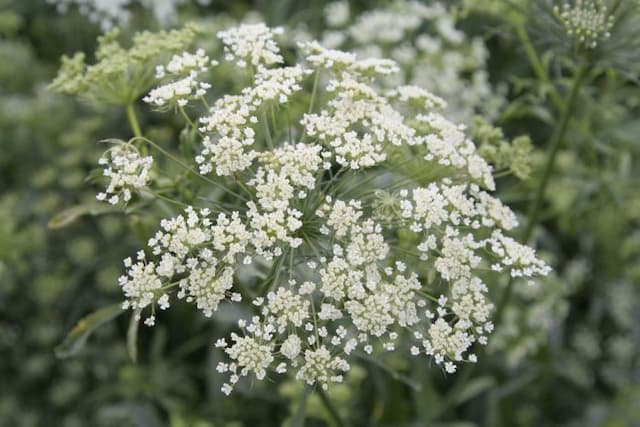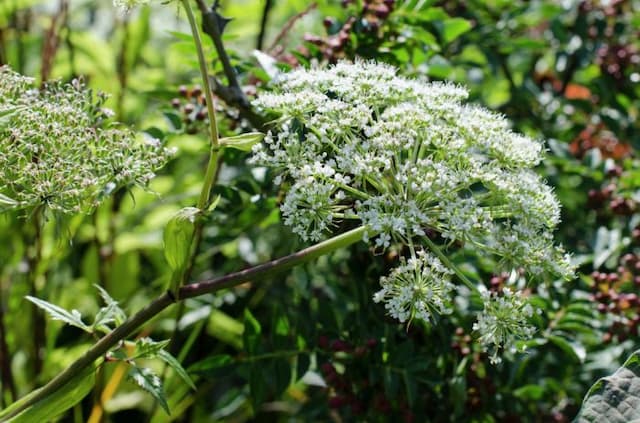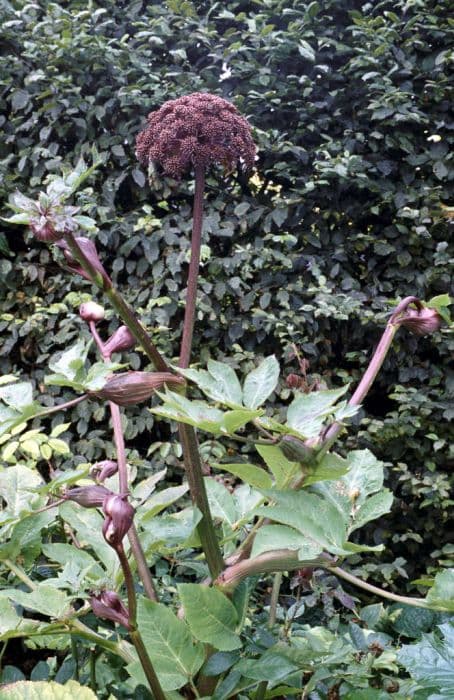Cushion Bolax Azorella trifurcata

ABOUT
Azorella trifurcata, commonly known as cushion plant or cushion bolax, is a dense, mat-forming perennial that bears lush greenery. Resembling a large mossy cushion, the plant has a compact and rounded habit, with deep green, glossy leaves tightly packed together. The foliage comprises small, three-parted leaves that overlap each other, forming a texture that is both soft and firm to the touch. Each individual leaf is divided, resembling a trident with three distinct sections that emanate from a single point. During the flowering season, the cushion plant produces small, inconspicuous yellow flowers that nestle within the foliage, almost hidden by the dense leaves. These blooms add a subtle texture and color variation to the plant without detracting from its overall plush appearance. The overall impression of Azorella trifurcata is of a hardy, tightly-knit ground cover that provides a continuous carpet of vibrant greenery in the landscape.
About this plant
 Names
NamesFamily
Apiaceae
Synonyms
Cushion Bolax, Cushion Plant, Bolax Gummifera
Common names
Azorella caespitosa, Bolax trifurcata, Bolax gummifera.
 Toxicity
ToxicityTo humans
Yareta is generally not known for being toxic to humans. There are no well-documented symptoms of poisoning from ingesting this plant, and it does not contain known toxins that would pose a risk upon ingestion. However, it is always essential to exercise caution and avoid consuming plants that are not clearly identified as safe.
To pets
Similar to humans, the Yareta plant is not commonly known to be toxic to pets. There are no widely recognized symptoms of poisoning for animals that have ingested this particular plant. As with any non-food plant, caution should be exercised, and pets should not be allowed to ingest this or any other plants not specifically intended for animal consumption.
 Characteristics
CharacteristicsLife cycle
Perennials
Foliage type
Evergreen
Color of leaves
Green
Flower color
Yellow
Height
1 inch (2.54 cm
Spread
1 foot (30.48 cm
Plant type
Herb
Hardiness zones
7
Native area
South America
Benefits
 General Benefits
General Benefits- Ground Cover: Azorella trifurcata, commonly known as cushion bolax, forms dense mats that can help prevent soil erosion and suppress weeds.
- Drought Resistance: Cushion bolax is known for its ability to tolerate periods of drought, making it suitable for xeriscaping and water-efficient gardens.
- Cold Tolerance: This plant is able to withstand cold temperatures, making it an ideal choice for alpine or rock gardens in colder climates.
- Low Maintenance: Cushion bolax requires minimal care once established, which is beneficial for gardeners seeking low-maintenance landscaping plants.
- Ornamental Appeal: The unique cushion-like appearance of this plant adds textural interest to garden compositions and rockeries.
- Wildlife Habitat: The dense foliage can provide microhabitats for insects and small wildlife within a garden ecosystem.
 Medical Properties
Medical Properties- This plant is not used for medical purposes.
 Air-purifying Qualities
Air-purifying QualitiesThis plant is not specifically known for air purifying qualities.
 Other Uses
Other Uses- Azorella trifurcata, commonly known as Yareta, has been historically used as a fuel source; its dense, dry matter burns slowly, similar to peat.
- In garden landscapes, Yareta is sometimes used as a unique, cushion-forming ground cover, providing an architectural aesthetic due to its unusual growth form.
- This plant has been utilized in creating living green roofs, especially in alpine settings, due to its hardiness and low maintenance requirements.
- The slow growth and resilience of Yareta make it a choice plant for rock gardens, where its texture and form contrast nicely with rocks and gravel.
- Crafters and model makers use dried sections of Yareta to simulate miniature trees and shrubs in dioramas and model train setups.
- Due to its compact nature, Yareta is occasionally used in bonsai, creating a unique representation of a tree-like structure in miniature form.
- In the Andes, Yareta was traditionally used to insulate homes, due to its compact and dense morphology that helps retain heat.
- Yareta is also employed in artistic installations, particularly in land art, as it embodies the concept of slow growth and persistence.
- Photographers and filmmakers often seek out Yareta-covered landscapes to capture the plant's otherworldly appearance and the stark beauty of its habitats.
- The Yareta's unusual appearance and vivid green color can be used as a natural dye in textiles, although this is not a common practice.
Interesting Facts
 Feng Shui
Feng ShuiThe Azorella trifurcata, commonly known as cushion bolax, is not used in Feng Shui practice.
 Zodiac Sign Compitability
Zodiac Sign CompitabilityThe cushion bolax is not used in astrology practice.
 Plant Symbolism
Plant Symbolism- Resilience: Azorella trifurcata, commonly known as Yareta, grows in extremely harsh high altitude environments, symbolizing the ability to thrive under tough conditions.
- Longevity: Yareta is known to live for thousands of years, representing enduring life and timelessness.
- Conservation: Due to its slow growth and vulnerability to overharvesting for fuel, the Yareta symbolizes the importance of environmental conservation and sustainable practices.
- Adaptation: The compact, dome-shaped form of Yareta helps it conserve heat and resist strong winds, symbolizing adaptability and ingenuity in the face of adversity.
 Water
WaterThe cushion plant prefers to be watered moderately and evenly, requiring around 1 inch of water per week. During active growth in spring and summer, ensure consistent soil moisture but avoid overwatering, as it dislikes soggy conditions. In winter, reduce watering to prevent root rot, especially if the temperatures are colder. A weekly check of the soil's moisture can be a good indicator; if the top inch is dry, it's time to water again.
 Light
LightYareta thrives best in full sun to partial shade conditions, making it suited for a spot that receives at least six hours of direct sunlight daily. Avoid deep shade locations as this might hinder its growth. If grown indoors, a south-facing window would be ideal to provide the bright light yareta needs for optimal growth.
 Temperature
TemperatureYareta grows well in a range of temperature conditions, as it is quite hardy. However, it fares best in temperatures between 50°F and 75°F. It can survive minimum temperatures down to 20°F but should be protected from prolonged freezing conditions. Avoid exposure to temperatures over 75°F, which can stress the plant.
 Pruning
PruningPruning yareta is generally not necessary due to its compact growth habit. However, if you wish to maintain its shape or remove any damaged or diseased leaves, the best time to do so is in the spring. Pruning should be minimal, only to clean up the appearance of the plant, and should be done every few years as needed to maintain its cushion-like characteristic.
 Cleaning
CleaningAs needed
 Soil
SoilCushion Bolax thrives best in well-draining soil with a slightly acidic to neutral pH of around 5.5 to 7.0. A mix consisting of equal parts sand, loam, and peat moss can provide good drainage and aeration. Ensure the soil is amended with organic matter to support its growth.
 Repotting
RepottingCushion Bolax does not require frequent repotting as it grows slowly; repotting every 2 to 3 years is typically sufficient. Always repot in the spring or early summer when the plant is actively growing.
 Humidity & Misting
Humidity & MistingCushion Bolax prefers low to moderate humidity conditions, resembling its native alpine environment. It can tolerate some humidity, but excessive moisture should be avoided to prevent root rot.
 Suitable locations
Suitable locationsIndoor
For Cushion Bolax, place in bright light, with well-draining soil.
Outdoor
In well-drained soil, Cushion Bolax proceeds in full sun to part shade.
Hardiness zone
7-9 USDA
 Life cycle
Life cycleAzorella trifurcata, commonly known as Yareta or Llareta, begins its life cycle as a seed, often dispersed by wind or animal activity. Once the seed germinates in a suitable location, usually in rocky, alpine regions of South America, it establishes a small rosette of leaves. The plant grows very slowly, developing a dense, woody, and cushion-like structure that can live for hundreds of years. Yareta reproduces infrequently, producing small, yellowish flowers that are pollinated by insects, leading to the development of seeds that will spread to continue the cycle. Sexual reproduction is rare due to the harsh conditions of its habitat, so Yareta often spreads vegetatively when fragments break off and root to form new plants. Given its extended longevity, each individual Yareta goes through numerous, infrequent reproductive cycles throughout its life.
 Propogation
PropogationPropogation time
Spring to summer
The most common method of propagation for Azorella trifurcata, commonly known as cushion bolax, is via division. This process typically takes place in either late winter or early spring before new growth begins. Gardeners should carefully dig up the cushion bolax and gently separate the plant into smaller clumps, ensuring that each new section has a portion of the root system intact. These divisions can then be replanted into well-draining soil at the same depth they were originally growing. It's important to water the newly planted divisions regularly until they are established and showing signs of growth. This method is favored because it maintains the characteristics of the parent plant and allows for relatively quick establishment of new plants.









